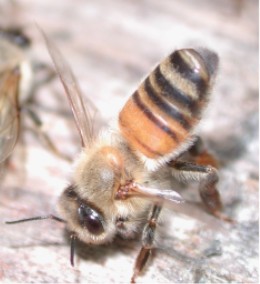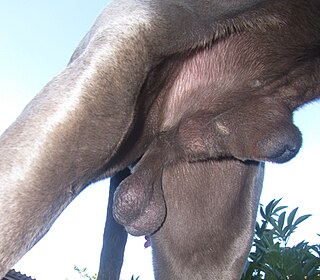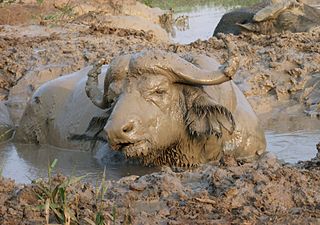
A pheromone is a secreted or excreted chemical factor that triggers a social response in members of the same species. Pheromones are chemicals capable of acting like hormones outside the body of the secreting individual, to affect the behavior of the receiving individuals. There are alarm pheromones, food trail pheromones, sex pheromones, and many others that affect behavior or physiology. Pheromones are used by many organisms, from basic unicellular prokaryotes to complex multicellular eukaryotes. Their use among insects has been particularly well documented. In addition, some vertebrates, plants and ciliates communicate by using pheromones. The ecological functions and evolution of pheromones are a major topic of research in the field of chemical ecology.

Anting is a maintenance behavior during which birds rub insects, usually ants, on their feathers and skin. The bird may pick up the insects in its bill and rub them on the body, or the bird may lie in an area of high density of the insects and perform dust bathing-like movements. The insects secrete liquids containing chemicals such as formic acid, which can act as an insecticide, miticide, fungicide, or bactericide. Alternatively, anting could make the insects edible by removing the distasteful acid, or possibly supplement the bird's own preen oil. Instead of ants, birds can also use millipedes. More than 200 species of bird are known to ant. A possibly related behaviour, self-anointing, is seen in many mammals.

The flehmen response, also called the flehmen position, flehmen reaction, flehmen grimace, flehming, or flehmening, is a behavior in which an animal curls back its upper lip exposing its front teeth, inhales with the nostrils usually closed, and then often holds this position for several seconds. It may be performed over a sight or substance of particular interest to the animal, or may be performed with the neck stretched and the head held high in the air.

The Panamanian white-faced capuchin, also known as the Panamanian white-headed capuchin or Central American white-faced capuchin, is a medium-sized New World monkey of the family Cebidae, subfamily Cebinae. Native to the forests of Central America, the white-faced capuchin is important to rainforest ecology for its role in dispersing seeds and pollen.
In ethology, territory is the sociographical area that an animal consistently defends against conspecific competition using agonistic behaviors or real physical aggression. Animals that actively defend territories in this way are referred to as being territorial or displaying territorialism.

Grooming is the art and practice of cleaning and maintaining parts of the body. It is a species-typical behavior.

The rut is the mating season of certain mammals, which includes ruminants such as deer, sheep, camels, goats, pronghorns, bison, giraffes and antelopes, and extends to others such as skunks and elephants. The rut is characterized in males by an increase in testosterone, exaggerated sexual dimorphisms, increased aggression, and increased interest in females. The males of the species may mark themselves with mud, undergo physiological changes or perform characteristic displays in order to make themselves more visually appealing to the females. Males also use olfaction to entice females to mate using secretions from glands and soaking in their own urine. Deer will also leave their own personal scent marking around by urinating down their own legs with the urine soaking the hair that covers their tarsal glands. Male deer do these most often during breeding season.

The capuchin monkeys are New World monkeys of the subfamily Cebinae. They are readily identified as the "organ grinder" monkey, and have been used in many movies and television shows. The range of capuchin monkeys includes some tropical forests in Central America and South America as far south as northern Argentina. In Central America, where they are called white-faced monkeys ("carablanca"), they usually occupy the wet lowland forests on the Caribbean coast of Costa Rica and Panama and deciduous dry forest on the Pacific coast.

Scent gland are exocrine glands found in most mammals. They produce semi-viscous secretions which contain pheromones and other semiochemical compounds. These odor-messengers indicate information such as status, territorial marking, mood, and sexual behaviour. The odor may be subliminal—not consciously detectable. Though it is not their primary function, the salivary glands may also function as scent glands in some animals.

Zoopharmacognosy is a behaviour in which non-human animals self-medicate by selecting and ingesting or topically applying plants, soils and insects with medicinal properties, to prevent or reduce the harmful effects of pathogens, toxins, and even other animals. The term derives from Greek roots zoo ("animal"), pharmacon, and gnosy ("knowing").

The wedge-capped capuchin or Guianan weeper capuchin is a capuchin monkey from South America. It is found in northern Brazil, Guyana and Venezuela. Cebus olivaceus is known to dwell in tall, primary forest and travel over long distances during the day.
A pseudo-penis is any structure found on an animal that, while superficially appearing to be a penis, is derived from a different developmental path.

In traditional Chinese medicine, a deer penis is said to have important therapeutic properties.

Robust capuchin monkeys are capuchin monkeys in the genus Sapajus. Formerly, all capuchin monkeys were placed in the genus Cebus. Sapajus was erected in 2012 by Jessica Lynch Alfaro et al. to differentiate the robust (tufted) capuchin monkeys from the gracile capuchin monkeys, which remain in Cebus.

Almost all mammal penises have foreskins or prepuces, although in non-human cases, the foreskin is usually a sheath into which the whole penis is retracted. In koalas, the foreskin contains naturally occurring bacteria that play an important role in fertilization. In some bat species, the prepuce contains an erectile tissue structure called the accessory corpus cavernosus.

Comfort behaviours in animals are activities that help maintain the pelage, feathers, integuement or musculoskeletal system and increase the physical comfort of the animal.

Wallowing in animals is comfort behaviour during which an animal rolls about or lies in mud, water or snow. Some definitions include rolling about in dust, however, in ethology this is usually referred to as dust bathing. Wallowing is often combined with other behaviours to fulfil its purpose; for example, elephants will often blow dirt over themselves after wallowing to create a thicker "coating", or pigs will allow the mud to dry before rubbing themselves on a tree or rock to remove ectoparasites stuck in the mud.

Animal non-reproductive sexual behavior encompasses sexual activities that non-human animals participate in which do not lead to the reproduction of the species. Although procreation continues to be the primary explanation for sexual behavior in animals, recent observations on animal behavior have given alternative reasons for the engagement in sexual activities by animals. Animals have been observed to engage in sex for social interaction bonding, exchange for significant materials, affection, mentorship pairings, sexual enjoyment, or as demonstration of social rank. Observed non-procreative sexual activities include non-copulatory mounting, oral sex, genital stimulation, anal stimulation, interspecies mating, and acts of affection, although it is doubted that they have done this since the beginning of their existence. There have also been observations of sex with cub participants, same-sex sexual interaction, as well as sex with dead animals.

Scent rubbing is a behavior where a mammal rubs its body against an object in their environment, sometimes in ones covered with strongly odored substances. It is typically shown in carnivores, although many mammals exhibit this behavior. Lowering shoulders, collapsing the forelegs, pushing forward and rubbing the chin, temples, neck, or back is how this act is performed. A variety of different odors can elicit this behavior including feces, vomit, fresh or decaying meat, insecticide, urine, repellent, ashes, human food and so on. Scent rubbing can be produced by an animal smelling novel odors, which include manufactured smells such as perfume or motor oil and carnivore smells including feces and food smells.






















